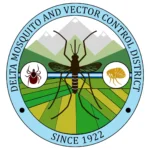Control
Any source of standing water that lasts for more than 3 days is a potential mosquito source. Vector control revolves around managing sources of standing water through physical, biological, and chemical control methods. District residents have a key role in mosquito control. They help reduce mosquito populations directly by managing potential sources in their own yards and indirectly by reporting potential sources off their property for treatment by the District.
Physical Control
Physical control methods modify the environment where vectors are found to reduce breeding sites, harborage, and access to people. For mosquito control, most of these techniques focus on water management such as source reduction. Without a source of standing water, the mosquito can not develop from an egg into an adult.
Source Reduction
Examples of source reduction includes:
- Throwing away unnecessary items that may collect water
- Removing plant trays
- Dumping water from containers
- Filling ruts and puddles with soil
Improved Water Flow
In general, mosquitoes prefer to lay their eggs in stagnant or slow moving water. Removing obstructions from gutters, ditches, drains, and other waterways allows water to flow freely and reduces mosquito breeding in those sources.
Physical Barriers
Physical barriers stop mosquitoes from accessing a water source to lay eggs or from accessing a host to bite. Examples of physical barriers include:
- Window and door screens
- Screens covering yard drain openings
- Bed nets
Vegetation Management
Adult mosquitoes rest in shady, protected areas such as weeds or bushes while waiting for a host to bite or to digest a meal. Removing weeds next to the house, mowing the lawn, and regularly trimming shrubs can help reduce areas where adult mosquitoes can safely rest.
Biological Control
Biological control methods use natural predators, pathogens, or parasites to reduce mosquito populations. Delta Vector Control District uses two types of biological control.
Mosquitofish
Mosquitofish (Gambusia affinis) an effective predator of mosquito larvae and are a great alternative to chemical control. They readily adapt to their environment, multiply quickly, and can consume massive numbers of mosquito larvae, up to three times their body weight every day! These fish are small, with adult females usually measuring less than 2.5 inches and adult males under 1.5 inches. They vary in color, depending on their immediate environment, from a light silver to a darker olive green.
However, mosquitofish are not a native to California and thus cannot be released in any waterway that connects to waters of the US or where native species may be present. As such, these fish are mainly used in holding basins, ornamental ponds, unmaintained pools, watering troughs, water reservoirs, and dairy ponds throughout the District.
Would you like to request free mosquitofish for your pond or water feature? Complete an online request here or call 559-732-8606 during regular business hours.
Microbial Control
Microbial control methods use living microorganisms or their by-products to control vector populations. Delta Vector Control District uses products containing naturally occurring soil bacteria Bacillus thuringiensis israelensis (Bti), Bacillus sphaericus (Bs), and spinosad to control mosquito larvae.
Chemical Control
Chemical control methods use natural or synthetic pesticides that target adult or larval mosquitoes. These pesticides are registered with the Environmental Protection Agency (EPA) and approved for public health use in California.
Immature Mosquitoes
Pesticides that target immature mosquito stages are called larvicides. Larvicides work by killing the immature mosquito before it can develop into an adult. They are typically applied to water sources that cannot be easily drained and that do not support the survival of mosquitofish. Larvicides can also be applied to large sources that will dry out and only need to be treated for a short amount of time. In addition to biological control methods listed above, insect growth regulators (IGR) and surface films can be used to control immature mosquitoes when necessary. Surface films are the only chemical control method that targets both larvae and pupae.
Adult Mosquitoes
Pesticides that target adult mosquitoes are called adulticides. Adulticides work by killing the adult mosquito when it comes into contact with the adulticide. The District uses adulticides to reduce the risk of mosquito-borne disease transmission to residents. The decision to treat a specific location is based on many factors including virus detection in mosquito samples, human cases, mosquito abundance, and the availability of staff and equipment.
Adulticides are applied using ultra-low volume (ULV) equipment that is mounted on a truck. This is referred to as ground ULV. Ground ULV is carried out usually in urban areas to control adult mosquitoes. The adulticides are applied at very low dosages. The low dosages, plus natural degradation by UV light and water, ensure minimal risk. The District uses pyrethroid-based products for ground ULV adulticiding. Pyrethroids are a synthetic insecticide, modeled after a botanical insecticide produced primarily from the flowers of Tancetum cinerariifolium, which is a species in the chrysanthemum plant family. These botanical compounds act as the plant’s own insecticide to keep insects away.
Do you want to be notified of future adult mosquito treatments? Please complete the form here for adulticide treatment notification.
Over-the-Counter Products
Many products available to the public are advertised as mosquito control methods. The effectiveness of these products vary widely. Before buying, research any product you intend to use. Always carefully read and follow the product label before applying any over-the-counter product. Never use a product for a purpose other than its intended use. Be sure to tell your pest control company what products you have used to avoid unintended reactions between public health pesticides and over-the-counter product.
You can contact Delta Vector Control District or the National Pesticide Information Center for more information on the active ingredient of a specific product.
Social Media Feed on Previous Adult Mosquito Treatments
Service Request? Get in Touch.
Public Documents
Contact
1737 West Houston Ave
Visalia, CA. 93291
Ph. 559-732-8606
TF. 877-732-8606
Fax. 559-732-7441
Hours
Monday–Friday,
7:30 AM to 4:00 PM (excluding holidays)



